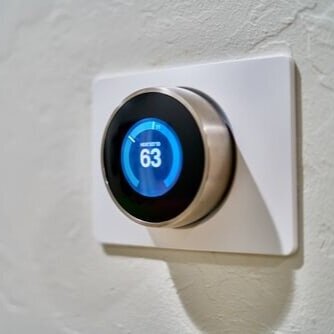Do You Need a Professional to Install a Thermostat?
A thermostat is the control center of your heating and cooling system. It regulates temperature by communicating with your HVAC unit to maintain comfort throughout your home. When your indoor environment reaches the set temperature, the thermostat turns the system off. When it drops below the desired level, it signals the system to turn on again.
If you've been wondering whether to upgrade your thermostat or who can install one when the time comes, you're not alone. Many homeowners are curious whether they need an electrician to replace a thermostat or if they can install a home thermostat on their own. While some try the DIY route, professional thermostat installation is usually the smarter, safer choice—especially with the range of high-tech models available today.
Types of Thermostats and the Temptation of DIY Installation
Modern homes use a variety of thermostats, from manual and digital models to programmable and smart devices. These upgrades offer improved energy efficiency, better comfort, and more control over your indoor climate. If you're still using an old-school dial model, switching to a modern HVAC thermostat is smart.
Installing a home thermostat might seem straightforward—just unscrew the old one and hook up a few wires, right? That's the impression many DIY enthusiasts have. While the process can be manageable in very simple systems, the truth is that most homes have more complex configurations. For example, an HVAC thermostat installation in a home with zoned heating or variable-speed equipment requires advanced setup, including precise wiring and calibration.
So, do you need a professional to install a thermostat? The answer is yes if your goal is reliability, efficiency, and safety.
Why Professional Thermostat Installation is Worth It
Whether replacing an older unit or upgrading to a smart model, calling a trained thermostat technician provides peace of mind and long-term benefits. Here's why you should rely on a pro.
Better Understanding of HVAC Systems
Professionals understand how different HVAC systems operate and how to integrate the right thermostat for your specific setup. An AC thermostat installation requires a different approach than a furnace-controlled system. Technicians consider factors such as heating stages, voltage compatibility, and system zoning—things the average homeowner may not even consider.
When a homeowner tries to guess at compatibility or configuration, it can lead to frustrating performance issues or even equipment damage. A licensed HVAC thermostat installation technician can assess the system and choose the appropriate model and wiring approach.
Guidance on Selecting the Right Thermostat
Modern thermostats offer a wide variety of features. A programmable thermostat suits households with a consistent routine, while a smart thermostat offers remote control, usage insights, and automated schedules. However, not every thermostat is compatible with every system.
An HVAC technician understands these nuances and can help you make the best decision. Whether your system is electric, gas, or includes multi-zone heating, they can point you toward models that match your needs. They'll also help you decide where to install the thermostat for optimal performance, avoiding areas with poor airflow or direct sunlight.
Avoiding Hazardous Consequences
Many homeowners ask, "Do I need an electrician to replace a thermostat?" While electricians can handle basic wiring tasks, thermostat replacement is typically best left to HVAC professionals who specialize in the relationship between thermostats and HVAC systems.
Installing a thermostat involves working with low-voltage wiring, which may seem simple but surprisingly complex. Newer thermostats often require a common wire (C-wire), and running new wires without proper training can lead to electrical shorts, damaged circuit boards, or blown breakers.
Even more concerning, improper installation can damage your HVAC system itself. If a thermostat sends the wrong signal, your air conditioner or furnace might overheat, cycle too frequently, or fail to respond. Hiring a trained thermostat technician minimizes the risk of costly repairs and helps avoid serious safety concerns like electric shock.
Preserving Your Warranty
Another factor to consider is your warranty. Many manufacturers specify that only professional installation will keep warranty coverage intact. Any warranty may be void if you install your new thermostat incorrectly and the system malfunctions. That means you'd have to cover the cost of repairs out of pocket.
Professional installation, on the other hand, protects your investment. If problems arise after installation, you have service records and a certified technician to address them quickly and efficiently—without voiding the warranty.
Who to Call to Replace a Thermostat
So, who should you trust with your thermostat replacement? Always choose a licensed and experienced HVAC contractor. These professionals are equipped to handle heating and cooling systems, whether a simple AC thermostat installation or a complete HVAC thermostat replacement.
If you're still wondering who to call to replace a thermostat, your local HVAC service provider is the best place to start. They'll evaluate your current setup, recommend compatible devices, and complete the installation according to industry best practices.
Installing Home Thermostats the Professional Way
Installing home thermostats isn't just about wiring—it's about calibration, placement, and integration. Professionals go beyond basic installation by:
Verifying system compatibility with the new thermostat
Identifying and connecting the correct wires, including the C-wire
Configuring heating and cooling settings
Programming schedules (for programmable models)
Linking mobile apps and Wi-Fi settings (for smart models)
Testing system operation to confirm proper communication
That level of precision is difficult to match with a DIY approach. And if you're upgrading a complex HVAC system or switching to a different thermostat model entirely, that precision matters even more.
Benefits of Hiring a Thermostat Technician
A professionally installed thermostat helps your HVAC system operate more efficiently, reduces energy consumption, and prolongs equipment life. Here are some of the top benefits:
Quick and correct installation – Avoid the guesswork and get a reliable setup.
Expert calibration – Maximize performance with fine-tuned settings.
Reduced energy bills – Better control means less waste.
Peace of mind – Skip the troubleshooting and know it's done right.
Ongoing support – Have a go-to pro if adjustments or updates are needed later.
It's not just about convenience—it's about the long-term performance of your entire HVAC system.
Final Thoughts on HVAC Thermostat Replacement
While replacing a thermostat might seem like a minor upgrade, it's actually a vital component of your home's comfort system. A well-functioning thermostat ensures your HVAC system runs efficiently, responds accurately to temperature changes, and helps you stay comfortable every season.
So, can you install a thermostat yourself? Technically, yes. But should you? Professional thermostat installation is the better path if you want safe, efficient, and warranty-protected operation. From choosing the right model to wiring it correctly and calibrating it for your unique system, a qualified HVAC technician brings skill and experience that a how-to video can't match.
Don't risk damaging your equipment or compromising your comfort. When it's time for HVAC thermostat replacement, call a trusted professional who can deliver lasting results.
CMB Air specializes in offering services like indoor air quality, duct fogging, duct repair and maintenance, thermostat, and iWave air purifier. No hidden charges and fees. Call (813) 447-1443 today for consultation.

